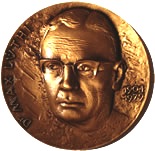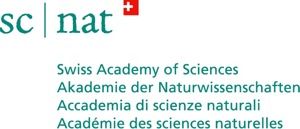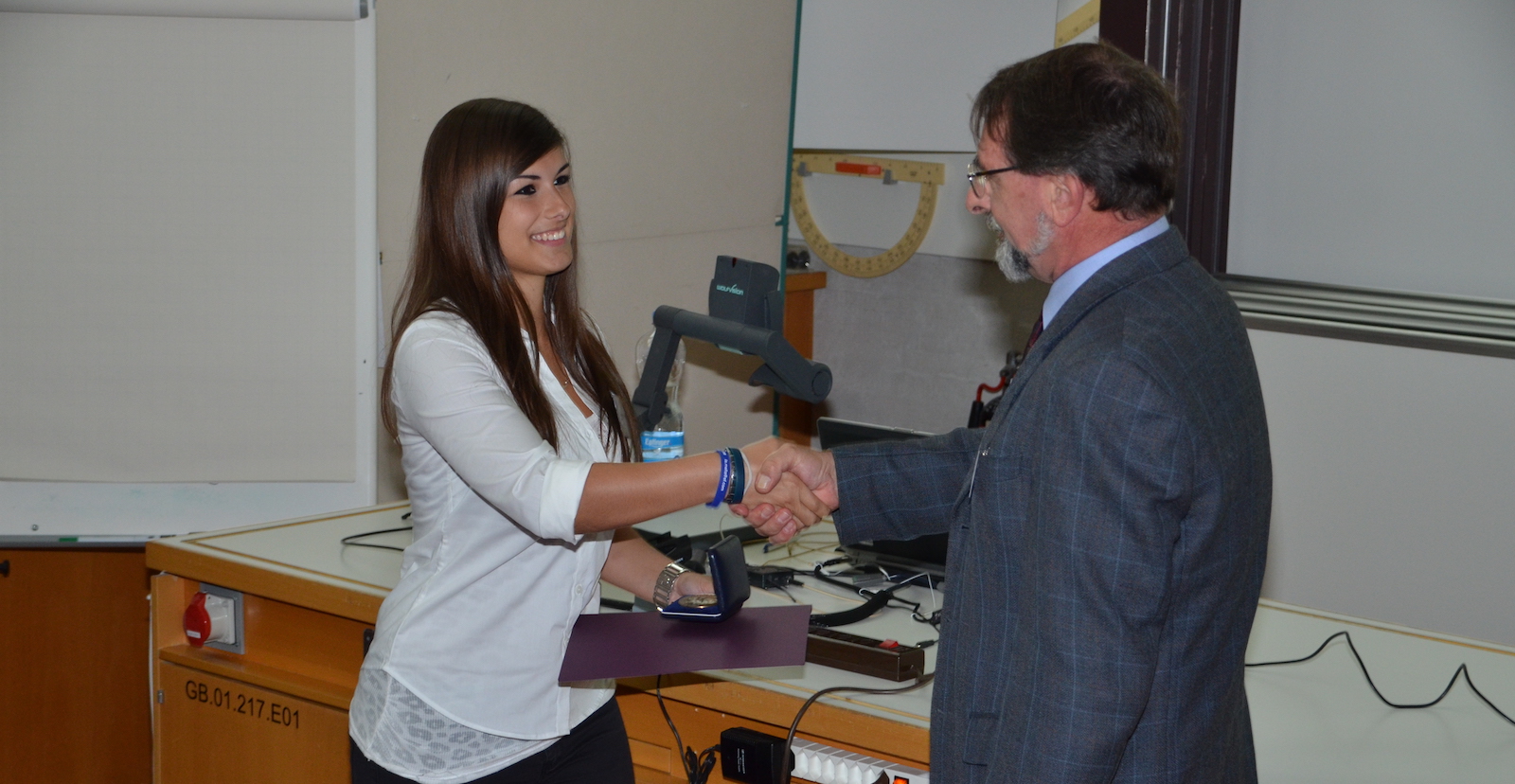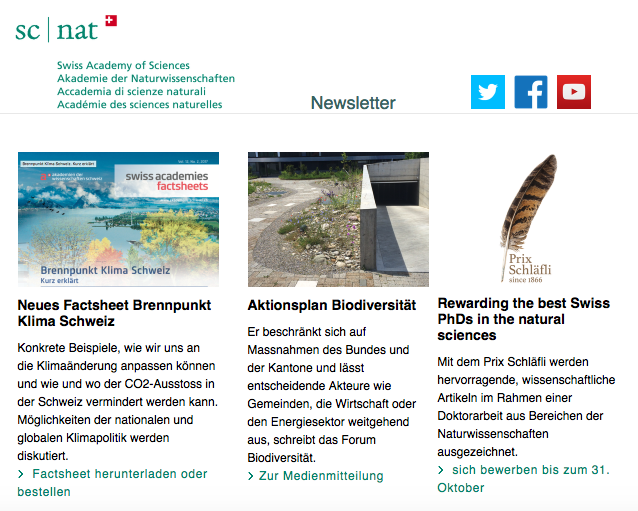Sonia de Andrade was awarded the Dr. Max-Lüthi Prize 2017
On the occasion of the BioTech 2017 conference at ZHAW in Wädenswil on September 8, 2017, Prof. Antonio Togni, President of the SCS Division of Chemical Education, awarded the Dr. Max Lüthi Award 2017 to Sonia de Andrade. Sonia, who did her BSc studies at ZHAW Wädenswil, received the prize in recognition of her Bachelor's thesis entitled «Advancement and validation of printable biomaterials and their potential use as tissue models». After the ceremony, Sonia gave a short lecture about the findings of her research.
We like to take the opportunity to congratulate Sonia de Andrade again for the outstanding thesis.
Dr. Max Lüthi Award
 CHF 1'000 and medal in bronze
CHF 1'000 and medal in bronze
The Dr. Max Lüthi Award is presented for an outstanding diploma thesis in Chemistry conducted at a Swiss University of Applied Sciences. Nominations must be submitted by the head of the Chemistry Department of a Swiss University of Applied Sciences. The prize is awarded annually.
Past Dr. Max Lüthi Award Winners
- 2016: Flavio Gall, ZHAW Wädenswil
- 2015: Yvan Mongbanziama, HEIA Fribourg
- 2014: Yannick Stöferle, ZHAW Wädenswil
- 2013: Peter Elmiger, ZHAW Wädenswil; Christophe Laporte, EIA Fribourg
- 2012: Lucie Sägesser, ZHAW Wädenswil
- 2011: Michael Brand, ZHAW Wädenswil
- 2010: Benjamin Otter (FHNW)
- 2009: Simon Lang (FHNW)
- 2008: Pitt Almendinger (ZHW); Caroline Emery (Haute Ecole Valaisanne and Washington State University); Daniel Mesitschek (Hochschule für Technik und Architektur Freiburg and Hochschule Offenburg)
- 2007: Ludovic Gremaud (Hochschule für Technik und Architektur Freiburg)
- 2006: Simon Lobsiger, Stefan Koller
- 2004: Cédric Clivaz
- 2003: Benoît Dubray
- 2002: Juan Luis Naveira; Samuel Rentsch
- 2001: Christiane Höfelein
- 2000: Pascal Beer; Thomas Roth
- 1999: Stefan Furrer; Olivier Vorlet
- 1998: Thomas L. Mindt
- 1996: Gottfried Blaser; Michel Houmard; Roger Mazotti
- 1995: Fabrice Greutert; Alexandre Krattinger; Roland Schürmann
- 1994: Daniel Gloor; Cyril Jeannet; Sam Derrer
- 1993: Stefan Lutz; Christoph Wyss
- 1992: Christian R. Hinderling; Marc E. Pfeifer; David Reichenbach
David Spichiger, SCS
14.09.2017
SCNAT sucht Chefredaktor/in Web (80 %)

Die Akademie der Naturwissenschaften Schweiz (SCNAT) mit ihren 35'000 Expertinnen und Experten engagiert sich regional, national und international für die Zukunft von Wissenschaft und Gesellschaft. Als Teil des Verbundes der Akademien der Wissenschaften Schweiz stärkt sie das Bewusstsein für die Naturwissenschaften als zentralen Pfeiler der kulturellen und wirtschaftlichen Entwicklung.
Für das «Portal Naturwissenschaften Schweiz» suchen wir per 1. Dezember 2017 oder nach Vereinbarung eine/n
Chefredaktor/in Web (80 %) Ihr Aufgabenbereich
Die SCNAT betreibt zusammen mit rund 60 Organisationen das Webportal Naturwissenschaften Schweiz (naturwissenschaften.ch), eine Zugangspforte zu naturwissenschaftlichen Inhalten, Angeboten und Organisationen der Schweiz. Als Chefredaktor/in Web unterstützen, beraten und schulen Sie die Partner des Portals und Sie sind für die Überprüfung der Qualität der Inhalte verantwortlich. Sie treiben die inhaltliche und konzeptionelle Weiterentwicklung des Portals voran und sorgen für eine wirksame Vermarktung. Für zentrale Bereiche des Portales, für das Organisationsportal der SCNAT und deren social media Kanäle bereiten Sie Inhalte attraktiv auf.
Ihr Profil
Sie sind initiativ und arbeiten gerne in unterschiedlichen Teams zusammen. Dank Ihrer Durchsetzungskraft treiben Sie Projekte voran. Sie schätzen Gestaltungsfreiraum und das Arbeiten in einem dynamischen Umfeld. In der Webkommunikation kennen Sie sich aus und Sie verfügen über Erfahrungen in der redaktionellen und multimedialen Aufbereitung von Inhalten für das Web und für social media Kanäle. Sie sind stilsicher in Deutsch oder Französisch und geübt in der anderen Landessprache sowie in Englisch. Sie verfügen über einen naturwissenschaftlichen Hochschulabschluss.
Wir bieten
- Arbeitsplatz in einem interessanten Umfeld in der Nähe des Bahnhofs Bern
- Zeitgemässe Sozialleistungen
Bitte schicken Sie Ihre vollständigen Unterlagen bis zum 30. September an (nur per E-Mail, wenn möglich ein einziges pdf-Dokument). Weitere Auskünfte erteilt gerne Marcel Falk, Leiter Kommunikation, 031 306 93 20.
David Spichiger, SCS
12.09.2017
SCNAT Newsletter, September 2017
Neues Factsheet Brennpunkt Klima Schweiz
Konkrete Beispiele, wie wir uns an die Klimaänderung anpassen können und wie und wo der CO2-Ausstoss in der Schweiz vermindert werden kann. Möglichkeiten der nationalen und globalen Klimapolitik werden diskutiert.
> Factsheet herunterladen oder bestellen
Aktionsplan Biodiversität
Er beschränkt sich auf Massnahmen des Bundes und der Kantone und lässt entscheidende Akteure wie Gemeinden, die Wirtschaft oder den Energiesektor weitgehend aus, schreibt das Forum Biodiversität.
> Zur Medienmitteilung
Rewarding the best Swiss PhDs in the natural sciences
Mit dem Prix Schläfli werden hervorragende, wissenschaftliche Artikeln im Rahmen einer Doktorarbeit aus Bereichen der Naturwissenschaften ausgezeichnet.
> sich bewerben bis zum 31. Oktober
Spuren des Klimawandels im Nationalpark
Besucher fragen immer wieder, welche Auswirkungen der Klimawandel auf den Schweizerischen Nationalpark habe. Der zeigt sich nämlich nicht nur durch wärmere Temperaturen oder weniger Schnee, sondern auch an Fauna und Flora.
> Spuren der Klimaänderung im Nationalpark entdecken
Reto Knutti ist neuer Präsident von ProClim
After eight years as Chair of ProClim, Heinz Gutscher has handed over his mandate to Reto Knutti. Heinz Gutscher has done an outstanding job with his inspiring ideas, critical questions and strong dedication. With Reto Knutti, Professor at the Institute for Atmospheric and Climate Science at the ETH, a perfect successor for the chair of the ProClim steering committee has been found.
> mehr zu ProClim
Chefredaktor/in Portal Naturwissenschaften Schweiz
Als Chefredaktor/in Web unterstützen, beraten und schulen Sie die Partner des Portals und Sie sind für die Überprüfung der Qualität der Inhalte verantwortlich. Sie treiben die inhaltliche und konzeptionelle Weiterentwicklung des Portals voran und sorgen für eine wirksame Vermarktung.
> sich bewerben bis zum 30. September
Antonio Loprieno präsidiert Europäischen Akademienverbund
Die Generalversammlung der All European Academies (ALLEA) hat Antonio Loprieno, den Schweizer Ägyptologen und ehemaligen Rektor der Universität Basel, für die Amtszeit 2018–2021 zum Präsidenten gewählt.
> mehr dazu
Sieben Forscher mit Balzan-Preis ausgezeichnet
Die Internationale Balzan-Stiftung hat dieses Jahr gleich fünf ihrer sonst vier Forschungspreise vergeben. Geehrt wurden insgesamt sieben Wissenschaftler aus Deutschland, Indien, den USA und Belgien.
> mehr Informationen
> Öffentliche Vorträge am 16. November in Bern
Weitere Veranstaltungen der SCNAT
> www.scnat.ch/events
The call for nominations for the EuCheMS Lecture Award
The call for nominations for the EuCheMS Lecture Award is now online.
The deadline for nominations is 31 December 2017.
Each year, the major achievements of one junior scientist working in chemistry in a country with a EuCheMS Member Organisation will be rewarded. The winner will receive a statuette and the opportunity to give a lecture at the next European Chemistry Congress (ECC) or at a conference of an EuCheMS Professional Network (PN). The guidelines for the Lecture Award can be found here.
Please check the updated guidelines, as the rationale behind the EuCheMS Lecture Award was significantly different until 2016.
David Spichiger, SCS
12.09.2017
Call for nominations for the European Chemistry Gold Medal
The call for nominations for the EuCheMS European Chemistry Gold Medal is now online.
The deadline for nominations is 31 December 2017.
Every two years, the exceptional achievements of one scientist working in the field of chemistry in Europe will be rewarded. The winner will receive a gold medal and the opportunity to give the opening lecture at the next European Chemistry (EuCheMS) Congress (ECC). The guidelines for this award can be found here.
This is the first time the European Chemistry Gold Medal will be awarded.
David Spichiger, SCS
12.09.2017
Page 95 of 304


